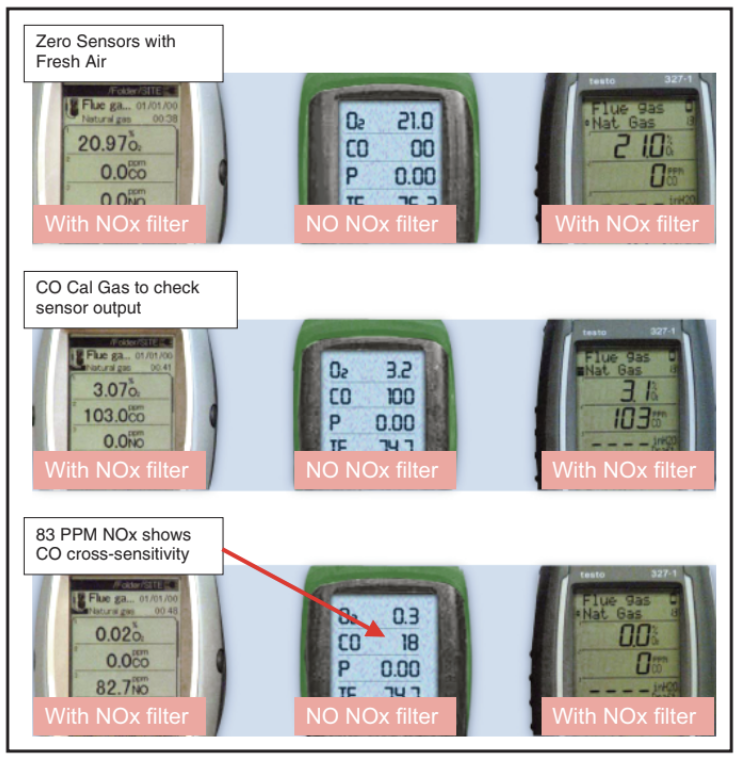Get Tech Tips
Subscribe to free tech tips.
Tool Selection: Combustion Analyzers
While gauge manifolds and manometers may only have one main function, some tools take several different measurements and will have more expansive specs. The combustion analyzer is one such example—combustion has so many elements, and we need something that can analyze the concentrations of several different substances as well as temperature.
As such, a combustion analyzer’s manual (or product page) will have a laundry list of accuracy and range specs. Not all combustion analyzers are created equal, so when we’re dealing with something as important as a customer’s health and safety, it’s important to understand how to know if a combustion analyzer is capable of giving you the readings you need.
Combustion Analyzer Specifications
Combustion analyzers collect several different readings at once, so we’ll need to keep in mind that they have a few more things to consider than manometers or gauge manifolds.
The equipment specs (and certainly the user manual) will lay out all the readings the CO will pick up, including operating ranges and possibly accuracy and resolution.
Let’s look at the UEi C165+ for residential and light commercial combustion equipment:
That’s a lot to take in! Luckily, UEi and TruTech Tools made it easy for us to see the range, resolution, and accuracy of each one.
All temperature readings have an operating range well within what you’d need for a combustion analyzer, a resolution of 0.1°F, and an accuracy tolerance that doesn’t leave a lot of wiggle room for doubt.
Unlike many other combustion analyzers, the C165+ also shows you a ratio of CO to CO2, which is a nice shortcut that lets you see how complete and efficient the appliance’s combustion is without having to do any math. While not necessary for everyone, it can be a powerful tool to show your customer how efficiently (or not) their appliance is burning fuel. A combustion analyzer should have at least an O2 or CO2 sensor.
Features to Keep an Eye On
Apart from the specs, you’ll want to pay attention to the features of a combustion analyzer if you’re considering buying a new one. These should be listed in the manual. Some analyzers have a NOx filter on their CO sensors, which filters out nitric oxide and prevents it from inflating your CO readings.
Combustion analyzers without a NOx filter may have higher CO readings, which may cause alarm when you’re not actually dealing with high CO and merely picking up nitric oxide. However, that doesn’t mean NOx doesn’t have its drawbacks; it’ll cause mechanical wear over time and is still a poisonous gas. The C165+ also has a purge pump that activates in CO concentrations above 2000 PPM, which protects the tool and makes it stay accurate for longer. Many combustion analyzers have these built into them, but it’s worth checking the features to make sure the one you’re looking for does.

Credit: TruTech Tools
While not totally necessary, pressure sensors built into combustion analyzers can come in handy for measuring manifold pressure. You can measure pressure with a manometer, but a combustion analyzer with a pressure sensor can help you consolidate your toolset on gas appliance service calls—since measuring gas pressure should be part of your combustion appliance workflow anyway.
Some manufacturers also have recommended calibration intervals to keep your tools as accurate as possible. For the C165+, that’s one year. UEi makes it really easy and quick to ship your combustion analyzer to the factory for calibration with Service+. Some combustion analyzers even come with replacement sensors that allow you to get your analyzer back into commission quickly if your sensor fouls. All of this information should be available in the product manuals.
So, there’s a lot to consider when you pick out a combustion analyzer:
- Operating ranges must be within those of the appliances you work on
- Accuracy must be industry-standard or better (with guidelines for regular calibration)
- For safety, the resolution for temperature should be 0.1°F (on par with a digital oral thermometer) and 1 PPM for CO at most
- The combustion analyzer must include features that are useful for your specific work and workflows
- What sorts of features will protect the analyzer from high CO concentrations?
- How will you separate NOx from CO?
However, with tool specs readily available in the digital age, you can easily figure out which combustion analyzer will work best for you. Also, don’t forget the importance of a personal low-level CO monitor—keep yourself safe!











Comments
To leave a comment, you need to log in.
Log In